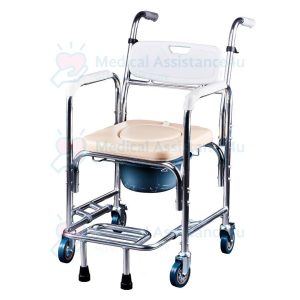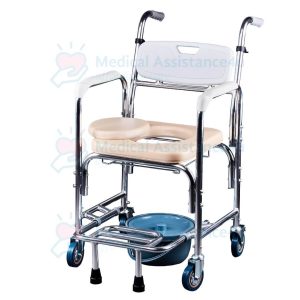Commodes
Product categories
- Bathroom Assistance (33
- Grab Bars (14
- Loo Support (3
- Mats (2
- Shower Chairs (8
- Commodes (7
- Mobility Assistance (47
- Crutches (2
- Exerciser (2
- Walking Aids (15
- Mobility Accessories (7
- Walking Frame (4
- Wheelchairs (13
- Ramp (1
- Equipment (2
- Bedroom Assistance (31
- Bedroom Accessories (18
- Beds (7
- Chairs (3
- Mattress (3
- Rental (8
- Daily Needs Assistance (16
- Clinical Equipment (5
Bathroom Commode
The commode can reduce risks of unfortunate incidents happening to individuals with mobility issues. A commode chair is equipped with support bars to aid with movement. It also minimizes the need for debilitated individuals to travel to the bathroom as it acts as a toilet.
Because of the autonomy that the commode offers, debilitated individuals are able to perform their toilet needs without assistance. This also eases the burden on their caretakers.
If privacy is of concern, a commode chair can help elevate that concern as the debilitated individual need not be dependent on others for their biological needs. This can also help preserve dignity for oneself if that is another cause for concern.
Given the affordability and comfort modern commodes offer, they are becoming a mainstay in elderly care.
Fequently Asked Questions (FAQ)
There are 2 main types of commodes, one with an inbuilt commode bucket for excretion without entering the bathroom and the other that has a hollow center which can be parked around the toilet bowl, allowing the user to excrete directly into the toilet bowl.
- Mobile Commode Chair
Commode chairs with wheels, mobile commode chairs are usually foldable and can be carried around conveniently
2. Shower Commode Chair
Designed to be used in the shower, shower commode chairs are anti-slip. Meant for individuals who have trouble standing or balancing
3. Bariatric Commode Chair
Strong with robust frames, bariatric commode chairs are able to withstand heavier weight and offers a larger seat area for those who needs it
The commode chair allows individuals with difficulty covering distance to the bathroom to ease their bowels in the chair itself. Saving them the hassle and the risk of movement with their limited mobility, without the need for external assistance.
Most commode chairs can double up as an indoor wheelchair.
Shower chairs are primarily used in showers to aid individuals who have trouble standing or balancing when bathing.
On the other hand, commode chairs are usually placed at bedside for ease of use without having to travel to the bathroom.
Commode is a common item that are supplied by medical assistive tools like Medical Assistance4u, Easy Wheels Pte Ltd, DNR Wheels and The Golden Concept.
A 3-in-1 commode has 3 functions in a single device. It can be used as a bedside commode, an elevated toilet seat and toilet safety frame.
MA4U provides commode bucket plastic bags that fit the commode bucket perfectly to prevent any leakages and to make cleaning easy and fuss free, reducing caregiver stress.
Commodes are subsidised under the Seniors’ Mobility and Enabling Fund (SMF), a fund by The Agency for Integrated Care (AIC).
The Seniors’ Mobility and Enabling Fund (SMF) provides holistic support for seniors to age in place within the community by extending subsidies to Singaporean seniors:
Requiring mobility and assistive devices for daily independent living and to remain ambulant in the community
Receiving government funded home care and care within the community, needing home healthcare items for their care
Head over to the AIC website to understand more!
Bathroom Commode
The commode can reduce risks of unfortunate incidents happening to individuals with mobility issues. A commode chair is equipped with support bars to aid with movement. It also minimizes the need for debilitated individuals to travel to the bathroom as it acts as a toilet.
Because of the autonomy that the commode offers, debilitated individuals are able to perform their toilet needs without assistance. This also eases the burden on their caretakers.
If privacy is of concern, a commode chair can help elevate that concern as the debilitated individual need not be dependent on others for their biological needs. This can also help preserve dignity for oneself if that is another cause for concern.
Given the affordability and comfort modern commodes offer, they are becoming a mainstay in elderly care.
Fequently Asked Questions (FAQ)
There are 2 main types of commodes, one with an inbuilt commode bucket for excretion without entering the bathroom and the other that has a hollow center which can be parked around the toilet bowl, allowing the user to excrete directly into the toilet bowl.
- Mobile Commode Chair
Commode chairs with wheels, mobile commode chairs are usually foldable and can be carried around conveniently
2. Shower Commode Chair
Designed to be used in the shower, shower commode chairs are anti-slip. Meant for individuals who have trouble standing or balancing
3. Bariatric Commode Chair
Strong with robust frames, bariatric commode chairs are able to withstand heavier weight and offers a larger seat area for those who needs it
The commode chair allows individuals with difficulty covering distance to the bathroom to ease their bowels in the chair itself. Saving them the hassle and the risk of movement with their limited mobility, without the need for external assistance.
Most commode chairs can double up as an indoor wheelchair.
Shower chairs are primarily used in showers to aid individuals who have trouble standing or balancing when bathing.
On the other hand, commode chairs are usually placed at bedside for ease of use without having to travel to the bathroom.
Commode is a common item that are supplied by medical assistive tools like Medical Assistance4u, Easy Wheels Pte Ltd, DNR Wheels and The Golden Concept.
A 3-in-1 commode has 3 functions in a single device. It can be used as a bedside commode, an elevated toilet seat and toilet safety frame.
MA4U provides commode bucket plastic bags that fit the commode bucket perfectly to prevent any leakages and to make cleaning easy and fuss free, reducing caregiver stress.
Commodes are subsidised under the Seniors’ Mobility and Enabling Fund (SMF), a fund by The Agency for Integrated Care (AIC).
The Seniors’ Mobility and Enabling Fund (SMF) provides holistic support for seniors to age in place within the community by extending subsidies to Singaporean seniors:
Requiring mobility and assistive devices for daily independent living and to remain ambulant in the community
Receiving government funded home care and care within the community, needing home healthcare items for their care
Head over to the AIC website to understand more!












